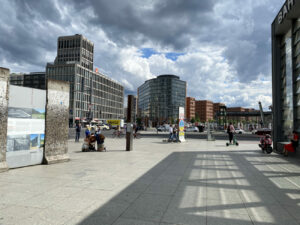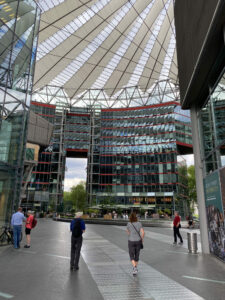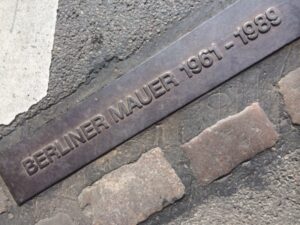BERLIN POTSDAMER PLATZ
 “Those faces? There on the posters? They’re the new Berliners!,” the old lady said, pointing to the scattered giant photos of faces scattered around Potsdamer Platz, across the street from her shop. In the plaza in central Berlin stood two or three dozen 10 foot high pictures of faces, Blacks, Browns, Latinos, Asians, Caucasians, Aborigines, Africans. “These people all live in Berlin today,” she added and smiled.
“Those faces? There on the posters? They’re the new Berliners!,” the old lady said, pointing to the scattered giant photos of faces scattered around Potsdamer Platz, across the street from her shop. In the plaza in central Berlin stood two or three dozen 10 foot high pictures of faces, Blacks, Browns, Latinos, Asians, Caucasians, Aborigines, Africans. “These people all live in Berlin today,” she added and smiled.
The diversity of the people in the photos was startling. A few decades ago, instead of being celebrated, many of the people represented here would have been sent to a concentration camp as non-Aryan.
I had spotted the posters as I emerged from the subway onto the plaza. When I found no explanation on them, I went into the nearest shop, the tiny Schmidt Schneiderei, a tailor’s, to ask and met 97 year old Frieda Schmidt. The faces, she told me, were a recent addition to the plaza to recognize the new diversity of Berlin’s mixed population in 2022.
 “It’s wonderful, isn’t it! The numbskull Nazis in the 30s and 40s, idiots to the core, born, bred, and raised as mindless sheep, with their purity stupidity!”, she said with a shake of her head. “I always suspected they’d grown up on sewage water. In the 1920s, when I was a little girl, Berlin was like these photos. People from all over the world came here, playwrights, artists, musicians, writers. My grandmother called them bohemians, but she still went to the jazz clubs and danced all night! By the time I was a teenager, it had all changed.” The smile faded. “By 1942 the Nazis had taken our shop. My father refused to tailor their uniforms. All we had left was that constipated Hitler. My mother said he hadn’t had a bowel movement in years!”, and she laughed again.
“It’s wonderful, isn’t it! The numbskull Nazis in the 30s and 40s, idiots to the core, born, bred, and raised as mindless sheep, with their purity stupidity!”, she said with a shake of her head. “I always suspected they’d grown up on sewage water. In the 1920s, when I was a little girl, Berlin was like these photos. People from all over the world came here, playwrights, artists, musicians, writers. My grandmother called them bohemians, but she still went to the jazz clubs and danced all night! By the time I was a teenager, it had all changed.” The smile faded. “By 1942 the Nazis had taken our shop. My father refused to tailor their uniforms. All we had left was that constipated Hitler. My mother said he hadn’t had a bowel movement in years!”, and she laughed again.
I asked her what Potsdamer Platz was like before the Nazis took full control. “The plaza was grand. Simply grand.” She looked out of the plate glass across the modern square, rebuilt just in the last 30 years, and described how it used to be before the steel-and-glass Sony Center, the German Railway skyscraper or the Ritz Carlton Hotel.
“We called it the Times Square of Europe,” Frieda continued. “The sidewalk cafes, boutiques, restaurants and luxury hotels. They were all so beautiful and elegant. The smell of coffee, the clacking of the trams, music of street performers, the vegetable and fruit vendors on every corner. On that corner,” she pointed, “was Wertheimer’s department store. They had the most fashionable clothes, so beautiful.” She became quiet as she stared out at the plaza. “We thought it would all last forever. And oh, the cinemas! How lovely they were. If a boy brought you to a Potsdamer cinema and cafe on a date, you knew he was serious!”
 But of course it didn’t last forever, in fact, it lasted only a couple more years. Goering had assured the Berliners they were safe but the Allied bombers came in 1943 and the Soviets shelled the city to dust in 1945. Potsdamer Platz was destroyed. Not one building was left intact. After World War II ended, the allies divided the town and the plaza. Its former heart was chopped in two. The line of divide between what would become East and West Berlin, ran down the middle of the square.
But of course it didn’t last forever, in fact, it lasted only a couple more years. Goering had assured the Berliners they were safe but the Allied bombers came in 1943 and the Soviets shelled the city to dust in 1945. Potsdamer Platz was destroyed. Not one building was left intact. After World War II ended, the allies divided the town and the plaza. Its former heart was chopped in two. The line of divide between what would become East and West Berlin, ran down the middle of the square.
“I came back here in June, 1945,” Frieda continued. “The plaza was a heap of rubble and ash. So was my father’s store. He opened a new one on Tauentzien Street in the West. This place,” she motioned with a sweep of her hand, “was just a big ruin, a junkyard of granite and concrete and broken glass. At least until 1961, you could cross it.”
On August 13, 1961, the East Germans and Russians built the Berlin Wall through the middle of Potsdamer Platz and the plaza became a no man’s land, deserted and mined. The city’s heart was gone, she thought, perhaps forever.
“This elegant plaza became a big, gray, empty weed choked field with rats and mice. Except for photos, you’d never know how wonderful it had been. We learned to live with it, as if it would always be that way. But nothing lasts forever, does it?”
In November 1989 the Wall began to come down, property confiscated by the Nazis then the Communists was returned to its original owners. Potsdamer Platz became a hot realty commodity and soon the rebuilding began. Big corporations like Sony and German Rail redeveloped the square and 77 years after the end of WWII, 32 years after the end of the Communists and the Cold War, the plaza regained its prominence in Berlin.
 “My father got back his land here but we had to rebuild the shop. I like it,” she looked around at the modern lighting and equipment, “but it doesn’t have the history the old shop had. And the plaza. It’s all bright and glassy but not like the big living room we once had. The buildings are too tall and shiny, no cubby holes or cute alleys like we had before”, she said. “But you know, if all of that hadn’t happened, it would have changed anyway.”
“My father got back his land here but we had to rebuild the shop. I like it,” she looked around at the modern lighting and equipment, “but it doesn’t have the history the old shop had. And the plaza. It’s all bright and glassy but not like the big living room we once had. The buildings are too tall and shiny, no cubby holes or cute alleys like we had before”, she said. “But you know, if all of that hadn’t happened, it would have changed anyway.”
If ‘that’ hadn’t happened, the Nazi era, the apocalyptic destruction of WWII and the Communists, it is possible that the Ritz would be here now anyway, Sony might have its umbrella covered atrium and German Rail would probably have its gleaming skyscraper. What wouldn’t have been here would be the bricks embedded into the streets, down the sidewalks, through the park, marking the line of the old Berlin Wall as it bisected the city, an icon of oppression, fear and death.
“Potsdamer Platz is not as lovely as it once was,” Frieda admitted, “but if it took the destruction of Naziism and Communism to have this plaza today with its wonderful photos, it’s worth it.”
What makes this square unique is not the gleaming modern structures found everywhere, but its history, the stories of the people who drifted across its early 20th century elegance, the stately 19th century buildings with tailors and cafes and bars and pubs and cabarets, the thriving bustling heart of a city which had just in the previous few decades made itself important on the world stage, the capital of a Germany that had been united as a nation only since 1870.
Between the 1920s and today, the transformation of the plaza from ‘cafe society’, to a mound of gray rubble divided by the scar of a Wall, to the modern cityscape of today is the striking tale of Potsdamer Platz and Berlin, unique to all other cities in the world. The gleaming newness of today’s plaza masks the history which most modern visitors miss.
 I knelt to run my hand across the letters in the line of bricks in the pavement, ‘BERLINER MAUER, Berlin Wall, 1961-1989’. It is something they don’t miss and won’t forget.
I knelt to run my hand across the letters in the line of bricks in the pavement, ‘BERLINER MAUER, Berlin Wall, 1961-1989’. It is something they don’t miss and won’t forget.
